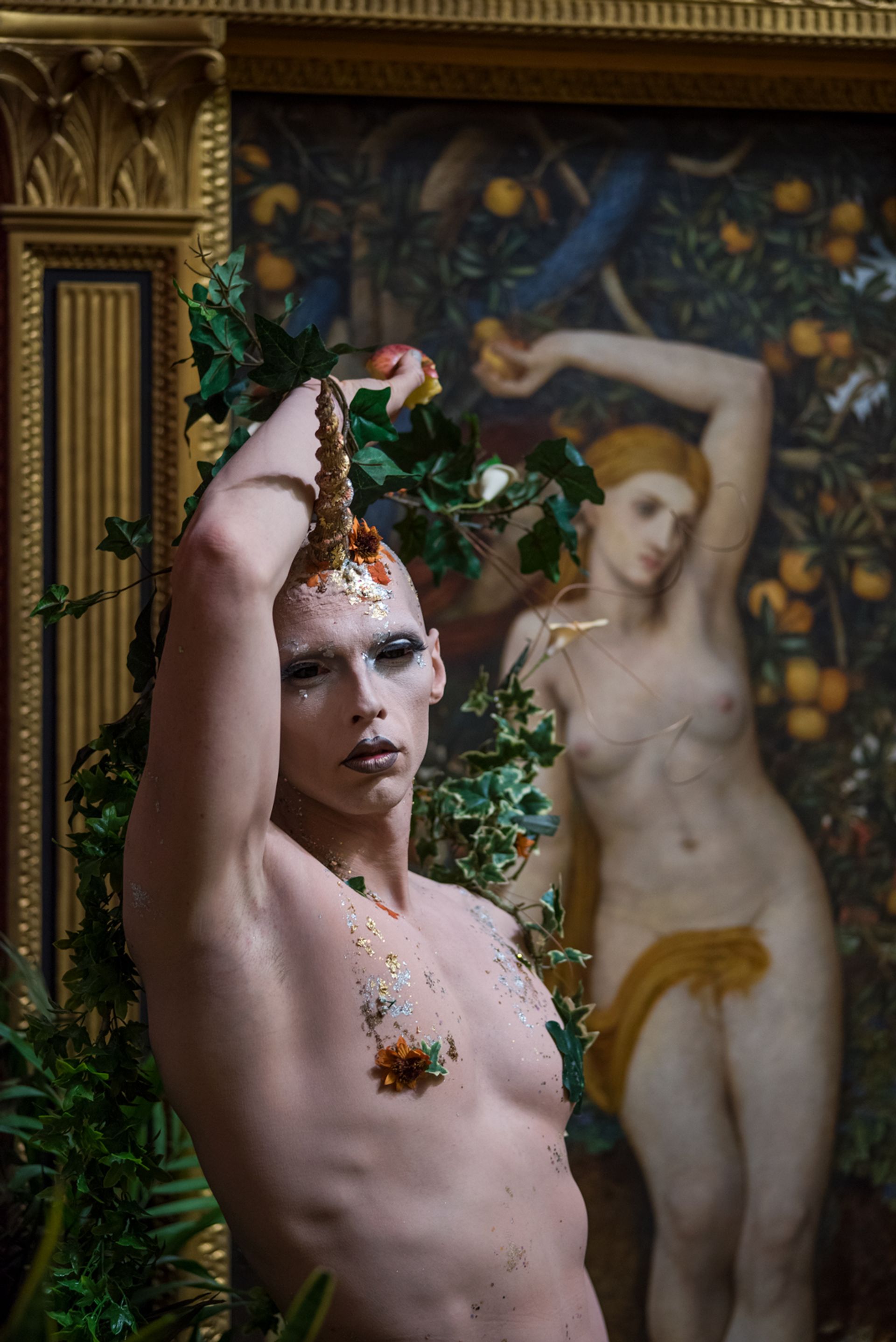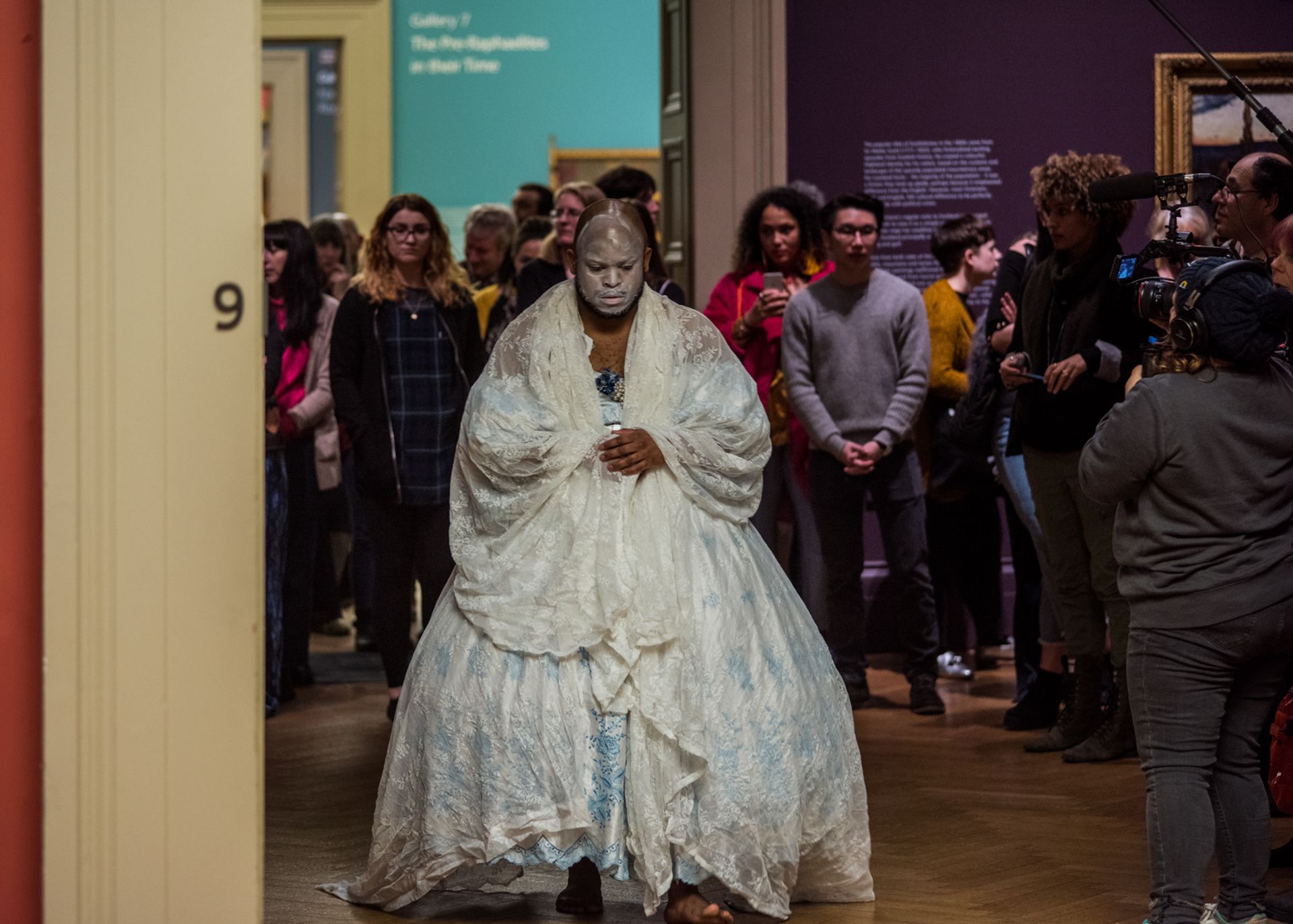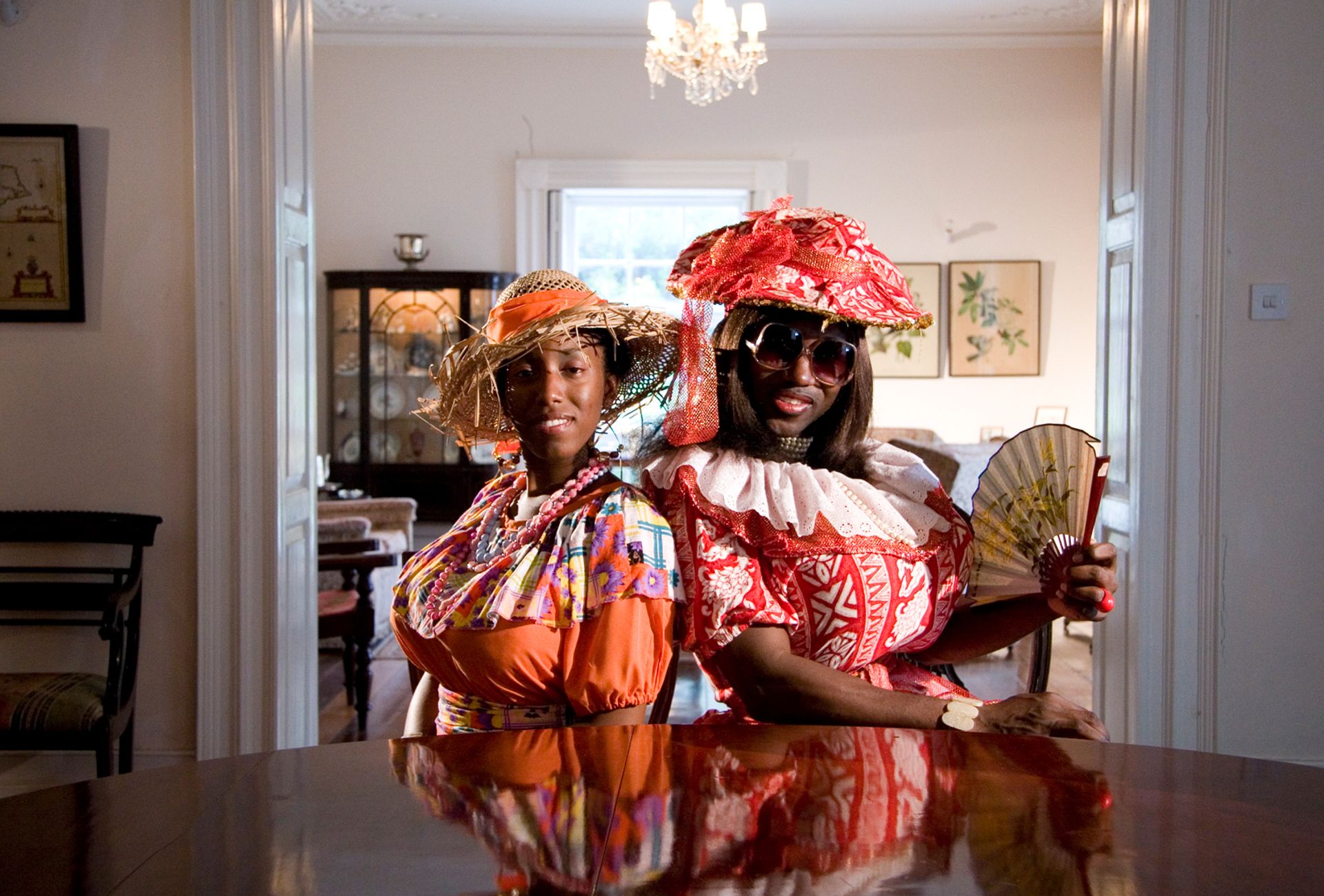Hylas and the Nymphs Waterhouse 1896 Manchester Art Gallery Public Domain
Sonia Boyce's exhibition at the Manchester Fine art Gallery (Magazine) gained an unexpected notoriety earlier it had even opened. In late January, the gallery took down one of its all-time-known works, Hylas and the Nymphs (1896) by John William Waterhouse, every bit office of a serial of activities in Boyce's evening "takeover", a regular event at the gallery. The evening would be the basis of her new half dozen-screen motion-picture show and wallpaper installation 6 Acts (2018). But the painting's removal became isolated from the evening's other moments and a row about censorship erupted, largely stripped of whatsoever context.
The background to the projection is complicated. Invited to exhibit at the gallery terminal year, Boyce instigated several discussions on her visits to the gallery over a menstruum of months—conversations that involved curators, gallery administration, volunteers, cleaners. Boyce saw her role as being "to facilitate the discussions, because I was trying to understand what was emerging from this particular context".
As the conversations adult, and the group swelled in number, two works became a item focus. The first was Othello, the Moor of Venice (1826) by James Northcote, a painting of the blackness actor Ira Aldridge, the painting that "started the collection as a whole", Boyce says. "I started to recollect that it would exist really interesting to accept somebody—and I thought very specifically of a performance artist called Lasana Shabazz—to piece of work with this painting as a starting indicate," Boyce says.
The other work was Hylas and the Nymphs, in which Waterhouse depicts the moment in the Greek myth where the boyfriend Hylas, Heracles's lover, was abducted past h2o nymphs. It features several young, nude women enticing Hylas into their spring. In the discussions, Boyce noted that the Waterhouse prompted "a discomfort amongst the staff themselves, not but the conversations that they've been having publicly with visitors to the gallery, but nearly an overarching narrative: first, a sense of the idealised female class, but also the female person effigy equally the apotheosis of death or something deathly, which is a very old trope". Hylas's sexuality was besides pregnant.
"Whether people will be too troubled by it or whether people will enjoy how they're being troubled, I can't predict."
After four sessions, Boyce says she told the growing group that "considering of this question of gender representation and the way in which the conversation was going, we need to not be binary most how nosotros're thinking around questions of gender and masculinity and femininity, that we need to complicate some of those questions, because there's been a lot of discussion virtually non-binary questions around representation". She knew that there was a "very dynamic drag scene" well-nigh the museum and fabricated contact with a grouping chosen The Family Gorgeous. They joined the discussions, as did Shabazz.
The last evening issue, was divided into vi performances. In one, Shabazz played with the graphic symbol of Aldridge, wearing a white dress and "whiting upwardly" as Aldridge would take had to when adopting Shakespearean roles across Othello; in others, The Family unit Gorgeous responded to other works in the drove. Boyce stresses that "there was no script, we didn't know what they were going to do, we didn't know what they were going to look similar – the performers really took on board quite a lot from the discussions, and worked actually hard and sensitively to remember most what emerged from those conversations that they wanted to have upwardly and annotate on and have an opinion virtually".

Cheddar Gorgeous functioning during Sonia Boyce's gallery "takeover" effect in Jan 2022 at Manchester Art Gallery Photo: Andrew Books
The determination to take down Hylas and the Nymphs emerged from the discussions. "Information technology wasn't unilateral," Boyce says. "There was a lot of ambivalence, but the consensus was that every bit 1 of the acts that would take place on the night of the takeover, this painting should come down." She adds: "My role is to say: 'If that's what you want to do, let'southward make that happen.'" The piece of work was taken down and visitors were invited to write their comments where the painting had hung.
The takeover programme had never attracted much attending in the press, and so at that place was "no anticipation that this was going to have such far-reaching impact, or even be taken to the media", Boyce says. Merely the artist Michael Browne, famous for his paintings of Manchester United footballers, saw the event, and posted on Twitter that it culminated in "the permanent removal of Pre-Raphaelite painting Hylas and the Nymphs, because the female staff view it as negative, bad taste, out of date. Is artists [sic] liberty in danger?"
This, says Boyce, "is how things in some means unravelled and spiralled". News reports appeared and there was a flurry of condemnation, and cries of censorship, including in a piece past the Guardian art critic Jonathan Jones, who neglected to mention Boyce, and wrote of "new puritans" returning us to "an era of repression and hypocrisy" and detected "the spectre of an oppressive past wearing new clothes". Elsewhere, the outcome was seen as a publicity stunt. "The idea that information technology was intentionally a stunt to draw attention to the museum or to myself was the furthest matter from [our minds]," Boyce says.
She adds that "the question of censorship is in at that place, merely if yous shout censorship from the off, then you can just become two means—it gets polarised just by that term". In that location is a counter-argument that information technology is those crying censorship who are the censors, that they are shutting downwardly new responses to canonical works by artists and performers exploring not-normative and not-binary representations of gender and sexuality.

Lasana Shabazz operation during Sonia Boyce's gallery "takeover" consequence in January 2022 at Manchester Fine art Gallery Photograph: Andrew Books
"The question at the heart of all of this is the question of ability," Boyce says, "and who's given legitimacy or takes up legitimacy to have an opinion. And really, a lot of the discussions we were having were well-nigh an invisible sense of who has the power to frame sure narratives." She suggests that the job of curators and artists is "to have an opinion, to make a sentence; judgement is the cornerstone of what we do".
Is she relieved at present that the Half-dozen Acts moving picture installation, including that contested removal, is complete, that the public can see it in its intended context and the contend can be refreshed? "[Visitors] volition see something that they're not expecting to see from what's been created from that event. [The film Six Acts] is very lush. Information technology'due south very, very funny, it's very troublesome; whether people volition exist too troubled past information technology or whether people will enjoy how they're being troubled, I tin't predict."
The furore around Hylas and the Nymphs has distracted from the importance of Boyce'south exhibition. It is only part retrospective: the drawings with which she established her reputation in the 1980s, like Missionary Position 2 (1985) in the Tate Collection, do non feature. Instead the evidence focuses on her "multi-sensory" practise from the 1990s onwards. She insists that her art is "still rooted in that early work, merely has taken on a different shape and a different kind of trajectory". Where Boyce was front and heart in her 1980s work, her collaborators are at present the protagonists. She sets upward the parameters and leaves it open for them to perform, even allowing her moving-picture show crew to capture the consequence equally they see fit. She then edits the material together.
Boyce says that "dialogue is a key theme throughout the work that I've done since the 1990s", and i of its most potent manifestations is through audio. For You, Only You (2007) in the Magazine show takes a choral Renaissance score and reworks it with the advanced audio creative person Mikhail Karikis and the choral group Alamire, with references to both Dada and jazz scat improvisation. These unlike cultural idioms fuse to course "a sonic history in the work that I make", she says, entangling different cultural identities.

A however from Sonia Boyce'south Crop Over (2007) picture show Collection Barbados Museum and Historical Society
This is visible, too, in Crop Over (2007), a pic which begins at Harewood Firm in Yorkshire, built on wealth generated through Caribbean plantations and slave labour, and explores the relationship betwixt the Britain the titular harvest festival in Barbados. "Musically as well as symbolically, in that harvest festival, there are African traditions, there are Scottish traditions, there are things that emerge straight from being in the Caribbean and in the Americas, that all collide," Boyce says.
Fundamentally, Boyce'southward art "is near people", she says, "and though some people may feel alienated by some of the subject matter, I am very keen on bringing them in and getting people to have unlike, complex relationships with the work." The Hylas and the Nymphs saga might have kicked off her MAG show with a shriller debate than she intended, just the attending it brought might, for some at to the lowest degree, prompt the more considered response she seeks.
Source: https://www.theartnewspaper.com/2018/03/29/at-the-heart-of-all-this-is-the-question-of-power-sonia-boyce-on-the-notorious-hylas-and-the-nymphs-takedown
0 Response to "Hylas and the Nymphs Waterhouse 1896 Manchester Art Gallery Public Domain"
Post a Comment